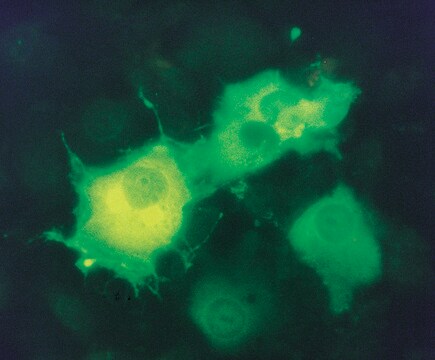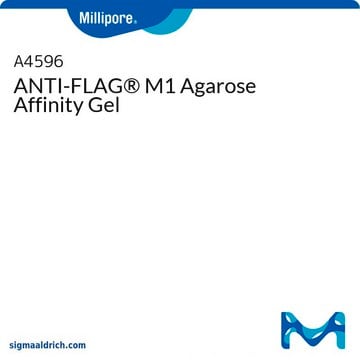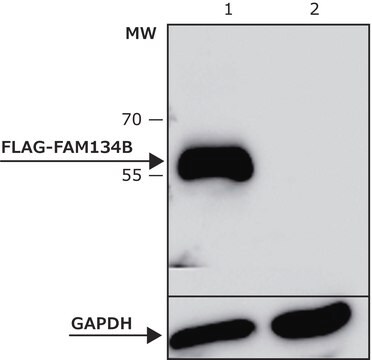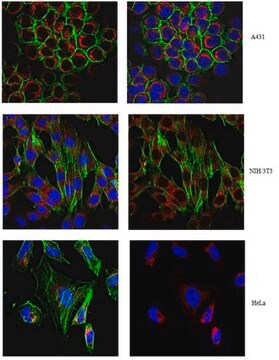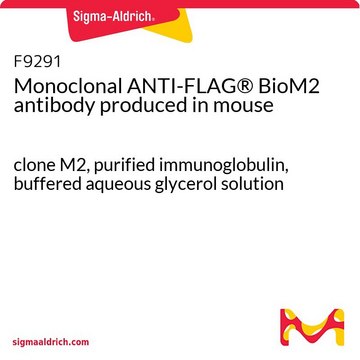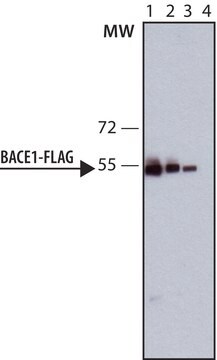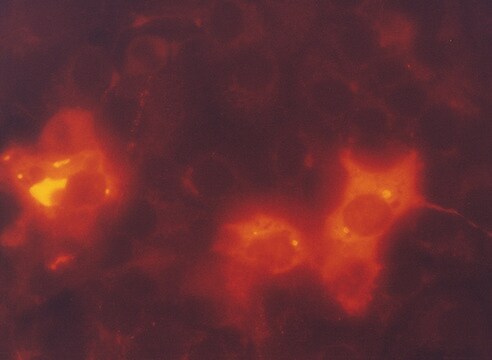MAB3118
Anti-DYKDDDDK (FLAG® epitope tag) Antibody, clone 2EL-1B11
ascites fluid, clone 2EL-1B11, Chemicon®
Synonyme(s) :
Anti-FLAG Antibody, FLAG Tag Antibody
About This Item
Produits recommandés
Source biologique
mouse
Niveau de qualité
Forme d'anticorps
ascites fluid
Type de produit anticorps
primary antibodies
Clone
2EL-1B11, monoclonal
Espèces réactives
vertebrates, E. coli
Réactivité de l'espèce (prédite par homologie)
rat
Fabricant/nom de marque
Chemicon®
Technique(s)
ELISA: suitable
immunocytochemistry: suitable
immunofluorescence: suitable
immunoprecipitation (IP): suitable
western blot: suitable
Isotype
IgG1
Conditions d'expédition
dry ice
Modification post-traductionnelle de la cible
unmodified
Description générale
FLAG® is a registered trademark of Sigma-Aldrich Biotechnology LP and Sigma-Aldrich Co.
Spécificité
Immunogène
Application
A 1:1,000-1:5,000 dilution of a previous lot was used in IF.
Immunoprecipitation:
A 1:1,000-1:5,000 dilution of a previous lot was used IP on recombinant proteins.
ELISA:
A 1:1,000-1:5,000 dilution of a previous lot was used in Enzyme-linked immunosorbent assay on recombinant proteins.
Note: Does not require Ca++ for binding.
Immunoblotting:
on recombinant proteins
Optimal working dilutions must be determined by the end user.
Epitope Tags & General Use
Epitope Tags
Qualité
Western Blot Analysis:
1:500 dilution of this lot detected Flag mTor on Flag-mTOR blot.
Liaison
Forme physique
Stockage et stabilité
Handling Recommendations: Upon receipt, and prior to removing the cap, centrifuge the vial and gently mix the solution. Aliquot into microcentrifuge tubes and store at -20°C. Avoid repeated freeze/thaw cycles, which may damage IgG and affect product performance.
Remarque sur l'analyse
Cells transfected with FLAG-tagged fusion vector
Autres remarques
Informations légales
Clause de non-responsabilité
Vous ne trouvez pas le bon produit ?
Essayez notre Outil de sélection de produits.
Code de la classe de stockage
10 - Combustible liquids
Classe de danger pour l'eau (WGK)
WGK 1
Point d'éclair (°F)
Not applicable
Point d'éclair (°C)
Not applicable
Certificats d'analyse (COA)
Recherchez un Certificats d'analyse (COA) en saisissant le numéro de lot du produit. Les numéros de lot figurent sur l'étiquette du produit après les mots "Lot" ou "Batch".
Déjà en possession de ce produit ?
Retrouvez la documentation relative aux produits que vous avez récemment achetés dans la Bibliothèque de documents.
Les clients ont également consulté
Notre équipe de scientifiques dispose d'une expérience dans tous les secteurs de la recherche, notamment en sciences de la vie, science des matériaux, synthèse chimique, chromatographie, analyse et dans de nombreux autres domaines..
Contacter notre Service technique


